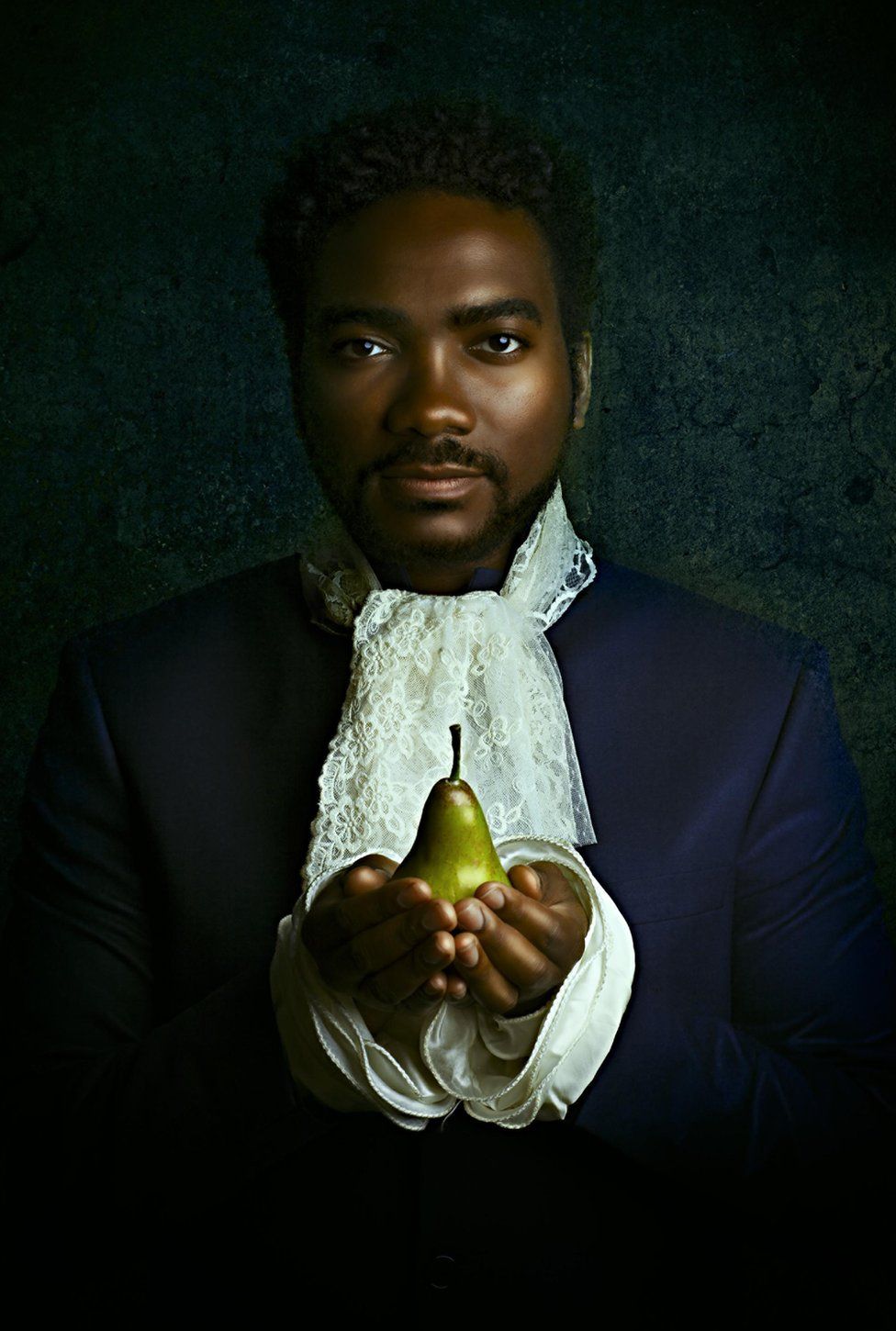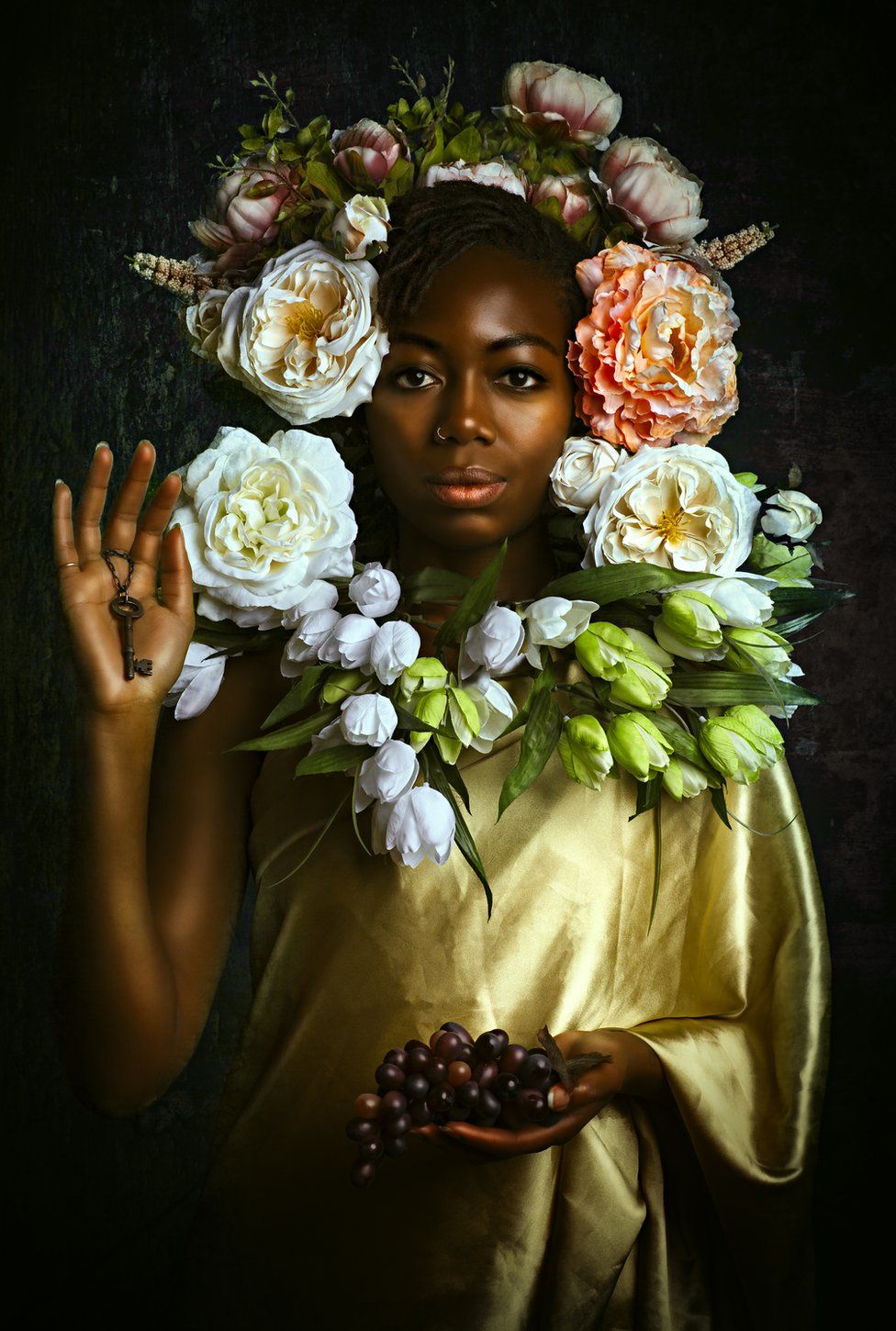
This article is more than
7 year oldChicago: Three artists challenging African-American stereotypes

The work, by artists Alanna Airitam, Endia Beal and Medina Dugger can be seen in an exhibition called How do you see me? at the Catherine Edelman Gallery in Chicago.
Here is a selection of highlights.
The Golden Age, by Alanna Airitam
Alanna Airitam addresses the absence of black people in the history of Western art, with rare appearances showing dark-skinned people "represented in paintings and films as domestic workers, slaves or barbarians".
In her series The Golden Age, the artist invited African-Americans to pose in the style of classic Dutch portraiture, to celebrate black identity and highlight the racial divide seen in art history.

Saint Lenox, 2017
Airitam said: "When I see the beauty and power in the eyes of the people in the portraits, it immediately counters all the negative stereotypes and narratives we receive on a daily basis.
"It is (and always will be) especially important for me to combat the barrage of dehumanising messages black people face through media with messages that clearly state that we are beautiful, powerful, valuable, worthy human beings and we're here to stay."

Saint Sugar Hill, 2017

Dapper Dan, 2017
Airitam pays homage to the Harlem Renaissance, a period of American history in the early 20th Century that saw a boom in African-American social and cultural expression, centred around Harlem in Upper Manhattan, New York.
The image above is named after Dapper Dan, the Harlem-based clothes designer who defined hip hop fashion in the 1980s and 90s.
Many of her images are named after places in Harlem.

Saint Minton, 2017
Airitam says that the absence of black people in Western art made an impression on her as a child going into museums and galleries.
"I never saw anyone who looked like me. We were not on the walls (unless shown in a way in which we were serving white people). We did not work there (unless we were cleaning or acting as security; again, serving).
"I remember being young and feeling confused, sad, and embarrassed about that."
The portrait below, named Queen Mary, is of a model named Mary. Her family is from Saint Croix, an island in the Caribbean Sea.
Mary shared a story with Airitam about three women who led a successful rebellion against Dutch colonialism in Saint Croix in 1878. One of the women was called Mary Thomas.
Airitam decided to name the portrait Queen Mary in honour of the story. The model is symbolically showing that the key to abundance is self-love, beauty, majesty.

Queen Mary, 2017
Am I What You're Looking For? by Endia Beal
In her series, Endia Beal positions her models against a fake backdrop of a traditional office setting, wearing an outfit that the model would choose to wear in the workplace.

Sabrina and Katrina, 2015
Beal, a professor at Winston-Salem State University in North Carolina, has spent the last four years using photographic narratives and video testimonies to examine the personal stories of minority women working within the corporate space.
The artist's previous personal experience of working in mostly white corporate workplaces includes people talking behind her back and making comments about her hair, which did not conform to their view of beauty.

Tianna, 2016
She says of the creative industry: "As a black, female photographer, I witnessed the under-representation of contemporary minority stories within fine art circles and photojournalism."
Many of the subjects in her series are students at the university where she works. She also travelled around North Carolina and photographed women in their childhood homes.
"These environments foster comfort allowing the women to be open about their concerns. I asked each woman to wear what she would love to wear to an interview and imagine she is waiting for the interview."

Christian, 2016
The women shared their personal difficulties in gaining employment after graduation: "Employers would tell them that their natural hair was unprofessional or their name was too difficult to pronounce and would suggest they alter themselves for the job.
"Rarely are these stories shared to colleagues or management in fear of rejection or lack of opportunities."

Melanie, 2016
Chroma: An Ode to JD 'Okhai Ojeikere, by Medina Dugger
In her portrait series, Medina Dugger pays homage to Nigerian photographer JD 'Okhai Ojeikere, who spent 40 years creating black and white photographic studies of African women's hairstyles.

nPurple Kinky Calabar, 2017
Ojeikere's work helped establish modern celebration of black hair culture, documenting African hair-braiding methods that date back thousands of years.
Nigerian hair culture is often an extensive process, which begins in childhood, with methods and variations being influenced by social and cultural patterns, historical events and globalisation.
Traditionally, Nigerian hairstyles can be purely decorative or convey deeper meaning and symbolism around social status, age and family traditions.

Blue Coiling Penny Penny, 2017
Dugger said: "As a white American living in Nigeria, creating work on Nigerian hair culture, I understood from the beginning that I first needed to learn about the history of the practice and knew that I wanted the process to be collaborative in nature."
In her portraits, Dugger experiments with historical and imagined hairstyles inspired by Ojeikere but also by Nigerian hairstylist Ijeoma Christopher, along with hairstyles she has seen in Lagos.

Blue Beri Beri, 2017
The women in the photos helped decide on the vibrant colours to suit their personal preferences.

Orange Koroba with Pony, 2017

Yellow Tip Twist, 2017
The exhibition How Do You See Me? runs at the Catherine Edelman Gallery, Chicago, until 27 October.




